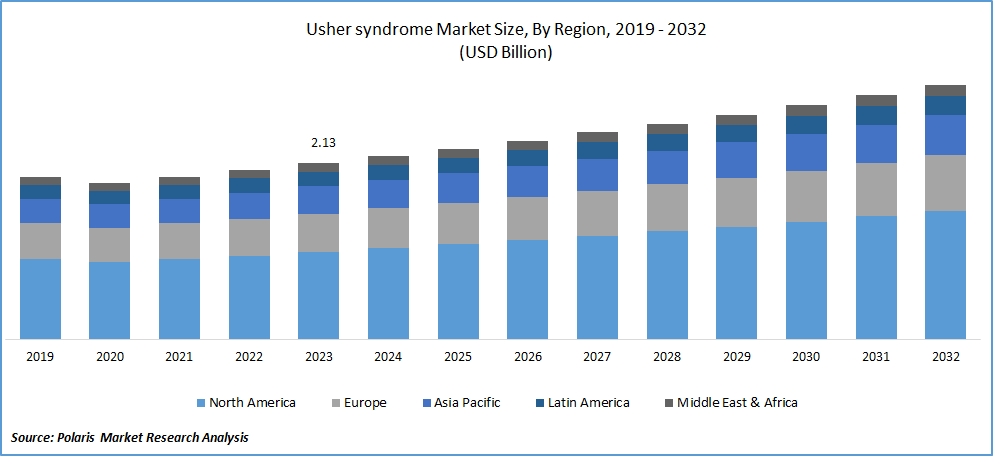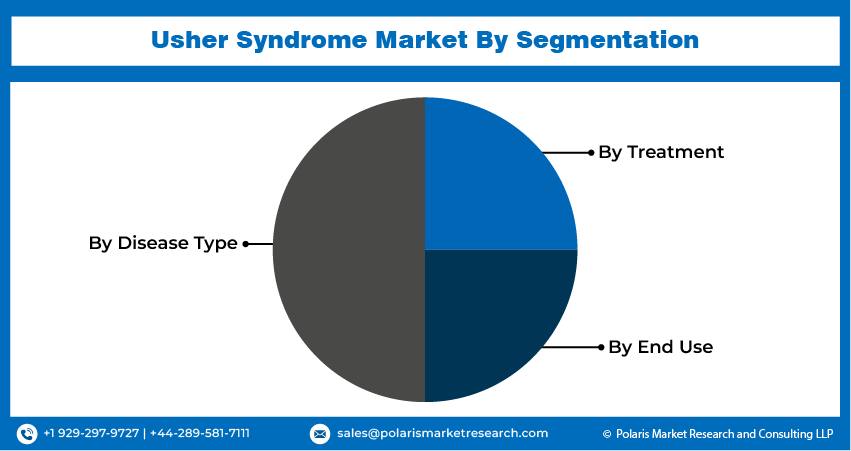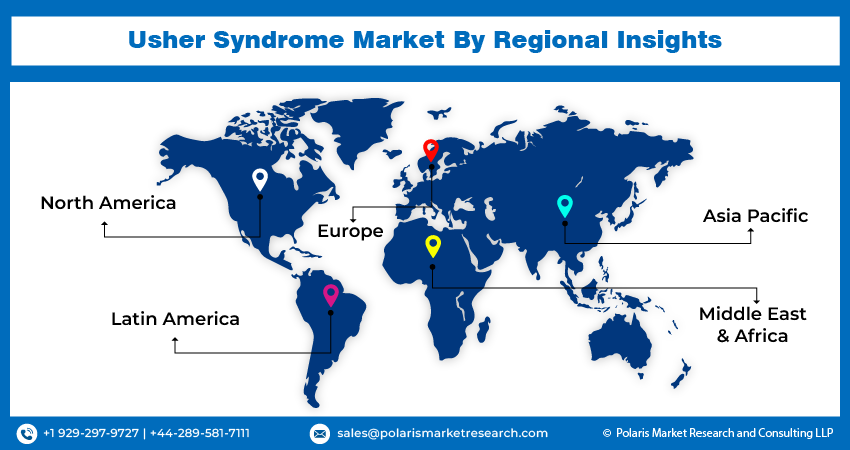
Usher Syndrome Market Share, Size, Trends, Industry Analysis Report, By Disease Type (Type1, Type2, Type3); By Treatment; By End-Use; By Region; Segment Forecast, 2024 – 2032
- Published Date:Mar-2024
- Pages: 117
- Format: PDF
- Report ID: PM4404
- Base Year: 2023
- Historical Data: 2019-2022
Report Outlook
Usher syndrome market size was valued at USD 2.13 billion in 2023. The market is anticipated to grow from USD 2.22 billion in 2024 to USD 3.08 billion by 2032, exhibiting the CAGR of 4.2% during the forecast period.
Industry Overview
Usher Syndrome is the most prevalent hereditary disorder affecting both hearing and vision loss. It is also called as Retinitis Pigmentosa’ or RP. These symptoms are the main signs of Usher syndrome.
Usher syndrome is a recessive condition. This implies that the individual must inherit the altered gene from both parents. An individual who receives the altered gene from one parent is a carrier of the syndrome but does not actually have it. There is one in four probability that a child born with two carriers of the same Usher syndrome gene will have such syndrome. An increase in the prevalence of hereditary and genetic illnesses drives the market growth opportunity.

To Understand More About this Research:Request a Free Sample Report
When governments invest in research for genetic disorders like Usher Syndrome, it can have several potential impacts. Research led to a deeper understanding of the genetic and molecular mechanisms behind Usher Syndrome, which is crucial for developing targeted therapies. Funding from governments can support clinical trials to test the safety and efficacy of potential treatments, bringing them closer to practical application.
- For instance, In January 2023, Nacuity, based in Dallas, initiated a Phase 1/2 clinical trial in Australia for its oral antioxidant therapy targeting individuals with Usher syndrome, as reported by the Fighting Blindness Association. The Foundation Fighting Blindness is committing up to $7.5 million to support the advancement of this promising drug, designed to address retinitis pigmentosa, Usher syndrome, and related conditions. The compound, N-acetylcysteine-amide (NACA), aims to mitigate vision loss by safeguarding retinal cells from oxidative stress.
The FDA's regulatory clearances are important in the development of novel treatments for the better cure of Usher syndrome. Regulatory approval of a novel medicine indicates that the treatment has fulfilled strict safety and efficacy requirements. These approvals are crucial for patient access to novel treatments, as well as for drawing funding and encouraging more studies in the field of treating Usher syndrome.
Moreover, there is no treatment for these illnesses at this time; there are several approaches to managing Usher syndrome. Usher syndrome is typically treated with cochlear implants, vision aids, vitamin A supplements, and speech, physical, and occupational therapy, among other therapies. The main factors anticipated to propel the growth of the global Usher syndrome treatment market over the forecast period, the rising awareness of the condition and its treatments, an increase in clinical trials and regulatory approvals for novel therapeutics, and advancements in cochlear implants and hearing aids also drive the Usher syndrome Market.
Key Takeaways
- North America dominated the largest market and contributed to more than 35% of share in 2023
- Asia Pacific expected to grow at the fastest CAGR during the forecast period
- By treatment category, hearing aid device segment accounted for the largest market share in 2023
- By end use category, the hospital segment is projected to grow at a highest CAGR during the projected period
What are the market drivers driving the demand for Usher syndrome market?
- Increasing Prevalence of Deafness or Hearing Loss
The increasing prevalence of Usher syndrome across the globe will facilitate market growth. According to the National Institute of Health, in Usher syndrome, deafness or hearing loss results from the atypical development of hair cells, which are responsible for sensing sound, in the inner ear. The severity of hearing impairment, ranging from moderate to profound, is typically present from birth and varies based on the specific type of Usher syndrome.
Alternatively, in less common cases, hearing loss associated with Usher syndrome may manifest during adolescence or later stages. Additionally, the syndrome can lead to significant balance issues due to irregular development of vestibular hair cells, specialized sensory cells responsible for detecting gravity and head movements.
Usher syndrome impacts an estimated 4 to 17 individuals per 100,000, constituting approximately 50 percent of all cases of hereditary deaf-blindness. It is believed to contribute to 3 to 6 percent of the total population of deaf children and an additional 3 to 6 percent of children experiencing hearing impairment.
For the treatment, devices like hearing aids can be used for this syndrome. The accessibility of the device and the global initiatives conducted by governments, corporations, and organizations to raise awareness of them indicate that the market for hearing aids will continue to rise in the upcoming year.
Which factor is restraining the demand for Usher syndrome?
- High Development Costs hamper the market growth.
Developing therapies or treatments for rare diseases like Usher syndrome often requires substantial financial investment. High development costs can limit the availability of resources for research and development, especially when compared to more prevalent conditions that may attract larger investments.
Investors, including pharmaceutical companies and venture capitalists, may be cautious about allocating funds to Usher syndrome research and development due to the perceived risks and uncertainties associated with developing treatments for rare diseases. This risk aversion can result in fewer resources being dedicated to advancing potential therapies. High development costs, coupled with the uncertainty of success, can discourage both public and private investors from projects with extended timelines, limiting the overall progress in Usher syndrome research.
Report Segmentation
The market is primarily segmented based on disease type, treatment, end-use, and region.
|
By Disease Type |
By Treatment |
By End Use |
By Region |
|
|
|
|
To Understand the Scope of this Report:Speak to Analyst
Category Wise Insights
By Treatment Insights
Based on treatment analysis, the market is segmented on the basis of device, therapy and drugs. In 2023, the hearing aid devices held the largest revenue share. Although there isn't a single therapy or cure for Usher syndrome, persons with the condition can manage their hearing loss with the help of hearing aids. By adolescence, children with type 3 Usher syndrome frequently experience hearing loss, which must be managed with hearing aids by mid-to-late adulthood. In order to help people with hearing loss detect sounds more easily and louder, hearing aids enhance sound waves. Their capacity for interaction and communication with their environment may be enhanced usher syndrome market revenue.
Furthermore, by improving or recovering hearing, hearing aids help people with Usher syndrome. They can also improve a person's general quality of life by managing hearing loss more effectively. With the use of hearing aids, they can engage more completely in social interactions, conversations, and everyday activities. Children with Usher syndrome can benefit from improved speech, language, and hearing development if their hearing aids are fitted early on. The market for hearing aid devices has shown a significant increase in the upcoming years.
By End-Use Insights
Based on end use analysis, the market has been segmented on the basis of hospital, ophthalmic clinics, ENT clinics and others. The hospital segment is anticipated to witness the fastest CAGR during the forecast period. Hospitals that offer a wide range of services, including specialized care for different age groups and medical conditions, are likely to attract a larger market share. This includes not only pediatric care but also services for adults and seniors. The government has taken steps to collect data for the usher syndrome from the hospitals and to, educate the parents regarding these syndromes and give preferable treatment for the child. Hence, the increasing awareness among individuals is expected to grow the usher syndrome market during the forecast period.

Regional Insights
North America
In 2023, North America accounted for the largest share in usher syndrome market, because of the region's significant presence of key players and sophisticated, well-established healthcare infrastructure; North America is expected to hold the biggest market share over the forecast period. North America is renowned for having a modern healthcare infrastructure, particularly in the United States and Canada. This infrastructure includes hospitals, ophthalmology clinics, ENT clinics, and other facilities that help with early identification, diagnosis, and improved management of Usher syndrome which contribute to drive the usher syndrome market.
Furthermore, a number of important international stakeholders, such as pharmaceutical firms, associations, and academic institutions, support the conduct of clinical trials and other research projects that advance cutting-edge treatment alternatives for improved management in the area. Because they bring knowledge, resources, capital, and investments to the area, their strong presence can aid in the market's growth and expansion and eventually establish market dominance.
Asia Pacific
Asia-specific regions are anticipated to witness significant growth in the market due to its increased population and technical advancement. Increased participation in clinical trials and research initiatives focused on genetic disorders, including Usher syndrome, can contribute to advancements in understanding and potential treatments.
Government initiatives and funding dedicated to genetic research and rare diseases can accelerate progress in Usher syndrome studies. Countries like India, China, and Japan are focusing on new technologies in electronic devices, research, and development into pharmaceutical products, clinical research, and others thus Usher syndrome Market is expected to show a sharp rise during the forecast period.

Competitive Landscape
The research institutions, genetic testing laboratories, and pharmaceutical companies focused on genetic therapies might be involved in studies related to Usher syndrome. Keep in mind that the information provided here may include something other than the latest developments. Companies engaged in genetic therapies or rare disease treatments might be exploring potential therapeutic interventions for Usher syndrome.
Some of the major players operating in the global market include.
- Audina
- Cochlear Ltd
- Earsmate
- Enhanced Vision
- Hearing Instruments, Inc.
- Johnson and Johnson service Inc.
- Med-El
- Nurotron Biotechnology Co. Ltd.
- Ototronix Diagnostics
- Rion Co. Ltd.
- Sonova
- Tobii Dynavox Us
Recent Developments
- In January 2023, Muna Naash, PhD, John S. Dunn Endowed Professor of biomedical engineering at the University of Houston, received a $1.6 million grant from the National Eye Institute. The funding aims to support the expansion of a gene therapy method for Usher Syndrome Type 2A, with the goal of potentially restoring vision loss in individuals affected by this rare genetic disease.
Report Coverage
The usher syndrome market report emphasizes on key regions across the globe to provide better understanding of the product to the users. Also, the report provides market insights into recent developments, trends and analyzes the technologies that are gaining traction around the globe. Furthermore, the report covers in-depth qualitative analysis pertaining to various paradigm shifts associated with the transformation of these solutions.
The report provides detailed analysis of the market while focusing on various key aspects such as competitive analysis, disease type, treatment and end-users,and their futuristic growth opportunities.
Usher syndrome Market Report Scope
|
Report Attributes |
Details |
|
Market size value in 2024 |
USD 2.22 billion |
|
Revenue forecast in 2032 |
USD 3.08 billion |
|
CAGR |
4.2% from 2024 – 2032 |
|
Base year |
2023 |
|
Historical data |
2019 – 2022 |
|
Forecast period |
2024 – 2032 |
|
Quantitative units |
Revenue in USD million/billion and CAGR from 2024 to 2032 |
|
Segments Covered |
By Disease type, By Treatment, By End-Use, By Region |
|
Regional scope |
North America, Europe, Asia Pacific, Latin America; Middle East & Africa |
|
Customization |
Report customization as per your requirements with respect to countries, region and segmentation. |
FAQ's
The key companies in Usher Syndrome Market players include Johnson & Johnson Services, Inc., Amgen Inc., Cochlear Ltd, Sonova, Audina Hearing Instruments Inc
Usher syndrome market exhibiting the CAGR of 4.2% during the forecast period.
Usher Syndrome Market report covering key segments aredisease type, treatment, end-use, and region
The key driving factors in Usher Syndrome Market are Rapid Pharmaceutical Advancements and Clinical Research
Usher Syndrome Market Size Worth $ 3.08 Billion By 2032 .
